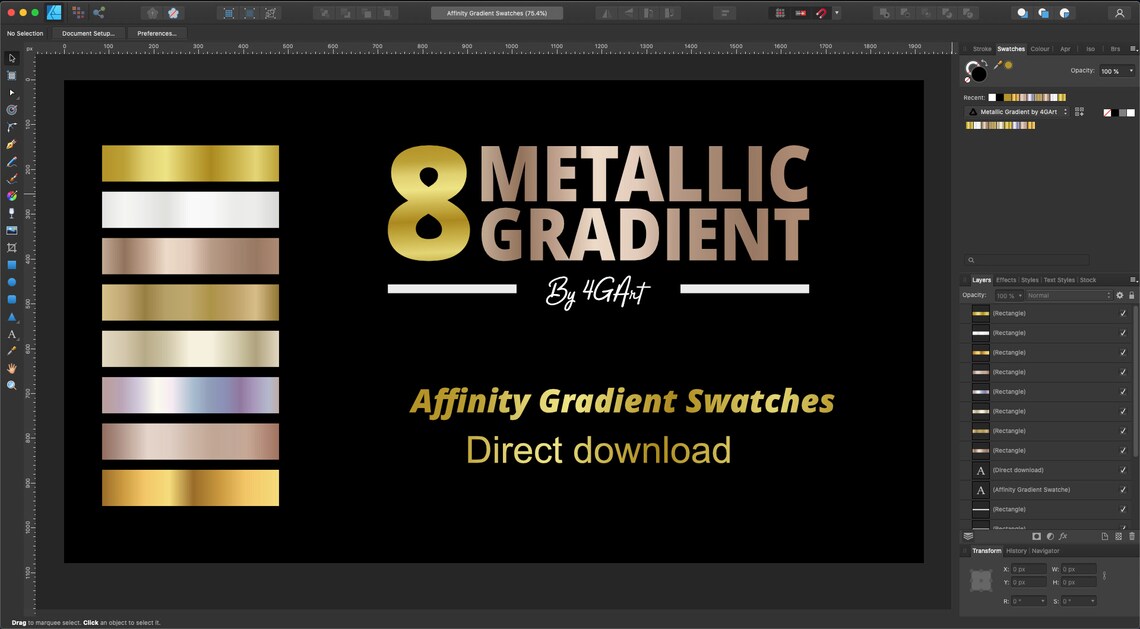
The change the location and orientation of your gradient, simply click and drag on either of the nodes to move them around: Moving the gradient handles allows you to change the gradient’s location and direction. Moving The Gradient’s Start and End Points The further in one direction you move it, the more intense the disparity will be: Moving the center point of the gradient will change its balance between the colors. Moving it will change the gradient’s balance to favor one color over the other. The thin line at the center of the gradient’s path represents the center point of the gradient. The change the colors of your gradient, simply click on one of the end points of the gradient (indicated as circular nodes that are filled with its current color) to select it and choose a new color from your Color menu at the top-right of your screen: Clicking the handles to select them will allow you to change their color in the Color menu. Now that we’ve applied a gradient fill with Affinity Designer, let’s go over how you can edit the gradient. Step 3: Edit your gradient using the menu options and on-canvas handles All of the other gradients can be edited in the same way. Once you’ve chosen your gradient type, it will be assigned a default start and end color, and you will see on-canvas handles that allow you to edit it: The on-canvas handles will allow you to edit the properties of your gradient further.įor this demonstration I have chosen a linear gradient. Disabling it will allow you to distort the gradient’s path so that it can follow an elliptical path. Enabling it will lock the proportions of the radial gradients you create. Maintain Fill Aspect Ratio: This setting is relevant to elliptical gradients.Reverse Gradient: Clicking this button will swap the start point of the gradient with its end point, effectively reversing the gradient’s path.Rotate Gradient: Clicking this button will cause your gradient to rotate 45 degrees counter-clockwise.Clicking on it will open up the Gradient Options menu. Gradient Options: This is a preview box that depicts the gradient that is currently applied.Click the menu to expand it and select the gradient of your preference. Type: The dropdown will allow you to choose the type of gradient you’d like to create.For this demonstration I will be applying it to the fill. Context: This setting determines whether the gradient will be applied to the object’s fill or its stroke.The options, from left to right, are as follows: Once selected, you should see the following options in the Tool Options menu towards the top of your screen: The tool options are described below. The Fill Tool can be accessed in the toolbar on the left-hand side of your screen: The Fill Tool is depicted as a rainbow colored disc/wheel.Īlternatively, you can use the keyboard shortcut ( G) to access it. The way that gradient fills are applied in Affinity Designer is with the Fill Tool - a tool that allows you to fill objects will gradients, patterns, and solid colors. Step 2: Grab the Fill Tool and choose the gradient type

You will see a blue bounding box around it once selected. You can apply a gradient fill to any object you’d like though, as long as it’s a vector path and not a rasterized image.Ĭlick on the object you’d like to apply a gradient to in order to select it.

For this demonstration I will be applying gradients to a circle that I’ve created: For this demonstration I will be applying a gradient to a circle. In order to apply a gradient fill in Affinity Designer you will first need an object to apply it to. Step 1: Select the object you want to fill Now that we’ve examined the different types of gradients you’ll be able to work with, let’s go over how you can apply a gradient fill in Affinity Designer. Unfortunately, Affinity Designer does not currently have the ability to work with meshes and mesh gradients. ConicalĪ conical gradient is a gradient format where several follow a circular path. However, the main difference is that elliptical gradients can be distorted to follow an elongated (or “elliptical”) path, whereas the path that elliptical gradients follow has a locked aspect ratio and must be perfectly circular. Much like elliptical gradients, radial gradients also follow a circular path. Along that gradient several colors are added - all of which follow a circular path. In the diagram above, the start point of the gradient is the red center point on the square, and the end point is the purple outer band at the edge of the square. Elliptical gradients are gradients that follow a round (or circular) path.


 0 kommentar(er)
0 kommentar(er)
